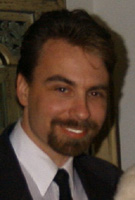Print This Page
|
Click to View All Speakers
|

Bill Scott
|
Bill Scott is a co-investigator of a research project studying somatization disorders at UCLAís Neuropsychiatric Institute with Lobsang Rapgay, Ph.D. Heís in the design process of a study investigating brain states during mindfulness meditation with Jeffery Schwartz, M.D. and Barry Sterman, Ph.D. He recently developed a new neuroimaging technology that creates a fractal signature from EEG and is successfully utilizing this technology as a form of EEG biofeedback in a process termed BrainPaintģ. He is the first author and principal investigator of a controlled study on addictions (n=121) which was published in August 2005 in The American Journal of Drug and Alcohol Abuse, with David Kaiser, Ph.D, Siegfried Othmer, Ph.D, and Steven Sideroff, Ph.D.
Bill was also the principal investigator and first author of an addiction research project that yielded a 79% success rate with Native American alcoholics. This study was with Dr. Eugene Peniston (in press). An interview with Bill by the Psychiatric Times was published as a feature article. Bill and David Kaiser presented research at the American Association for the Advancement of Science with Dr. David Kaiser. He trained the researchers Dr. John Gruzelier and Dr. Tobias Egner (members of Department of Cognitive Neuroscience and Behaviour, Imperial College Medical School) in the use of alpha-theta protocols. The results of this research project so improved music abilities among Royal Conservatoire of Music students that the Conservatoire adopted these protocols into the schoolís curriculum.
Bill has been published in the January 2000 issue of Clinical Electroencephalography (EEG), an official journal of the EEG and Clinical Neuroscience Society (ECNS). He contributed a chapter on alpha-theta EEG biofeedback in Jim Robbins' Book, "A Symphony in the Brain." He has presented his research and has taught workshops with Tom Brod, M.D. on anxiety disorders at three American Psychiatric Associations annual conventions.
In association with Michael Hoffman, Bill is also currently involved with the Narcotics Division of the American Embassy in South America where they are teaching their protocols to other researchers in order to quickly replicate their work in Latin America. He participated in the 4th annual Meeting of Experts on Demand Reduction for the Organization of American States.
Bill has been training EEG biofeedback practitioners since 1996 and has taught over two thousand of them at this time. Heís most passionate about evaluating and demonstrating EEG biofeedbackís effectiveness through research, refining assessment, improving protocol selection, measuring outcomes and discovering innovative ways to transfer his knowledge to practitioners and research teams. Heís been in private practice since 2000 in West Los Angeles and Malibu.
|

|
Workshop #386): Protocol Efficiency
This workshop teaches practitioners how to recognize progress or the lack thereof in their EEG biofeedback clients. About one in three clients have extraordinary reactions to their first session but what about the others? Itís important for clinicians to be able to tell when people are responding in positive and negative ways. Weíll cover what types of things tend to improve first in the first few sessions when you have the right protocols. Youíll also learn what things tend to worsen when you have the wrong ones.
Workshop #387): Protocol Efficiency
This workshop teaches practitioners how to recognize progress or the lack thereof in their EEG biofeedback clients. About one in three clients have extraordinary reactions to their first session but what about the others? Itís important for clinicians to be able to tell when people are responding in positive and negative ways. Weíll cover what types of things tend to improve first in the first few sessions when you have the right protocols. Youíll also learn what things tend to worsen when you have the wrong ones.
Plenary #367): The Neurophysiology of Fear and State Specific EEG Changes
Fear states were induced in subjects to determine how their EEG, heart rate, and mental processing would change when compared to a neutral condition. We found significant differences in cognition, EEG and heart rate.
Subjectís (15-30Hz) amplitudes and cognitive functioning significantly dropped in amplitude while experiencing fear. Half of them had significant reductions in alpha (8-11Hz) and theta (5-8Hz). Doesnít reducing alpha, theta, and high beta improve cognition? Or do we just need a new measuring stick for wave analysis that goes beyond amplitude, frequency and variability? Perhaps Iíve found one.
Details:
Workshop #386): Protocol Efficiency
Weíll spend the majority of this two hour course answering questions, going over cases and exploring the classís experiences.
Workshop #387): Protocol Efficiency
If everyone had significantly abnormal EEGs we tend to see them regress to the mean. What about those who donít. This is the majority of my practice and weíll spend the majority of this two hour course answering questions, going over cases and exploring the classís experiences.
Questions answered will be: How much beta? How much SMR? When do we start alpha-theta? What does it look like when people overdose on protocols? How do we handle overdoses? When do we need to add beta SMR to alpha theta protocols? How do you get a ballpark guess as to how many sessions one is likely to need? Why are negative reactions better than no reaction? How do we handle the placebo question? Why might we not be seeing beta or SMR significantly changing. What are common reasons people donít respond to alpha-theta training? How do we help clients handle change they asked for yet didnít expect to receive?
Iíll also cover language I use that seems to facilitate client understanding of the process. This makes it less uncomfortable to describe to their friends. Iíll also teach the class some techniques Iíve leaned on giving alpha-theta training for people with severe panic disorders.
Plenary #367): The Neurophysiology of Fear and State Specific EEG Changes
This talk is a follow-up to the talk Tom Brod and I shared last year entitled ďWhatís Happening When Nothingís Happening?Ē If Iím able to gather enough data of this new metric from a new ADD study weíve recently begun, youíll hear it here first. It will explain why we donít see people consistently declining in functioning when we reward for increases in alpha and theta. Or why can P300s or fMRIs show consistent increases and decreases functionality with beta-SMR training without changes in amplitudes in those bands. One thing we know for sure is that the brain isnít amplitude modulated or we would make more noise going under power lines than our old AM radios. Or was it really the radio buzzing when we drove under them? Iím kidding {poke}.
Perhaps including this metric in the feedback process is part of the increased progress Iíve been having in the last year. It also could lead to new discoveries in other symptomatology.
Co-presenter with Thomas Brod of MYSTERIES OF NF SUCCESS: What's Happening When"Nothing's Happening"?
Contact Info:
Bill Scott
18219 Coastline Drive
Suite #1
Malibu, California 90265
phone:
|
Click to View All Speakers
|

